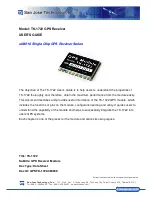
1.4) UNPACKING AND INSPECTION
Carefully remove the system parts from the packing container. Ensure that the following
system parts are enclosed:
•
GPS Receiver/Antenna
•
Interface Cable (10 metres)
Inspect the packaging and system parts for any signs of damage in transit. If any damage
is found notify the carrier and supplier immediately.
1.5) INSTALLATION
WARNING
Take care in fitting the GPS as incorrect fitting can cause irrepairable damage and would not be
covered by warranty. See Installation Instructions in the relevant Manual.
A 10 metre cable plugs in to the Antenna (an optional 15 m cable is available, Part
Number 510 541). The mounting position must be selected carefully. The satellite posi-
tions are continuously changing relative to the vessel and in addition, the vessel’s heading.
As reception is strictly “line of sight”, between each satellite and the receiving Antenna, it is
essential that the Antenna has a clear view of the hemisphere of sky from the horizon up-
wards. Minor shadows caused by rigging wires will not upset either reception or the result-
ant position fixing. Two effects may be caused by the proximity of metallic objects:
a) Shadowing, the “line of sight” being obscured and reception from one or more satel-
lites lost. Metal masts, radar scanners, radar reflectors or superstructures are typical
causes of such shadowing.
b) Distortion of the Antenna polar diagram which may decrease the effective level of
the received signal.
The antenna SHOULD BE MOUNTED:
•
more than 1 metre from wire rigging
•
more than 2 metres from metal objects greater than 200 mm in any direction and
above the Antenna base
•
more than 3 metres from other satellite services Antennas such as Geostar, Locstar,
Inmarsat
•
outside the possible beam width of an Inmarsat standard A Antenna or a Radar
•
with nothing on top of the unit
As the Antenna is receiving its signals from satellites above the horizon it is not neces-
sary to mount the Antenna at the mast top on sailing yachts or at the highest point on com-
mercial or other powered vessels. In fact there are disadvantages in that the accuracy of
GPS will tend to show the Antenna’s athwartships velocity component, dependent on the
height of the Antenna above sea level and the rolling period of the vessel.
The smaller vessel may roll quickly and an Antenna mounted from the mast top may
result in the display of a cyclic variation in Speed Over the Ground as well as small unnec-
essary position changes.
On larger power driven vessels and commercial ships, the rolling velocity is likely to be






















